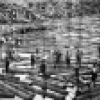Winter Horses
One of the most common questions I get about the horses is what do we do with them in the winter? It’s a good question, because there isn’t any work for them in the winter and spring around here. The mountains are full of snow, and we don’t have any cattle to work. So, about early December we take all the shoes off of them and turn them out onto hay meadows and other pastures. I check on them pretty frequently throughout the winter to make sure fences are up (they get drifted over sometimes, or deer break wires), but that’s about it until I gather them up in early May.
So, how does a horse stay warm in the bitter cold and wind and deep snow when its out in big fields on its own? Well, it turns out a horse is pretty well adapted to that scenario.
Horses have hundreds of thousands of years of evolution in northern climates, going well back before the last great ice age. Our horses, at least from December through May, more or less mimic their ancient ancestor’s situation. They’re just wandering around in big fields, eating and staying warm. The main elements they need for winter survival are their winter coats, shelter from the wind, feed, and water.
The winter coat is the most important. In response to the fading sunlight, the horse’s body starts producing his winter coat as soon as the days start getting shorter. His coat begins to grow his winter coat as early as July, shedding the shorter, thinner summer coat in October. This coat has longer and coarser hairs than the summer coat, and he uses them to keep warm by fluffing them up to trap heat. The individual hairs stand up rather than lying flat against the skin, which traps warm air close to its body and insulates him from the cold. This works remarkably well as long as his coat doesn’t get too wet and he can get out of the wind.
Thus the second important item - shelter from wind. This is particularly important out here were the winter winds can blow over 50mph during the winter. Wind blows through a horse’s thick outer coat, taking away the thermal warm layer he is relying on. Because this is something we have some control over, we put them in pastures that have access to tree covered river bottoms or with lots of tall brush to give them these natural windbreaks.
The next item is enough available feed for them to forage through the winter. Their internal process of breaking down their feed generates an amazing amount of heat, so the very nature of digestion provides a lot of body heat. Further, horses are remarkably good at pawing through the snow to get to the underlying feed. Much like elk and deer, they’ll paw down through 18” of snow or more to get to feed. Most of our pastures tend to have the hillsides clear off from the winds in winter, so usually they don’t have to paw too much to get to feed except after a deep snow.
Finally water is a very important element for a horse’s survival in winter. It is true that horses can eat snow and for short periods of time get enough water from that to survive. And, even when water is available they typically only go to water every other day. But access to open water is crucial to winter survival for general hydration, digestion of roughage (heat generation), and preventing colic.









